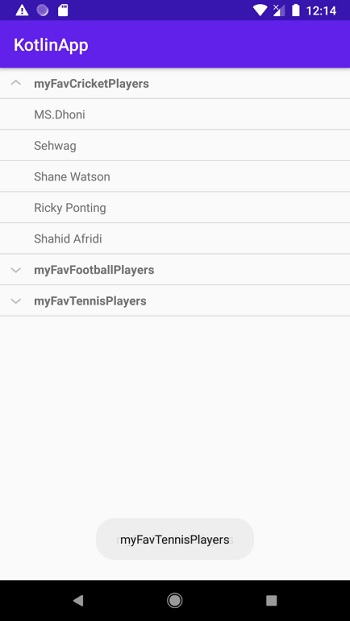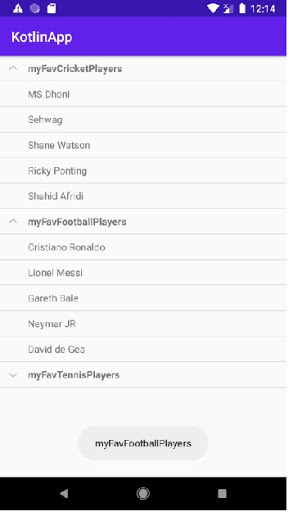
 Data Structure
Data Structure Networking
Networking RDBMS
RDBMS Operating System
Operating System Java
Java MS Excel
MS Excel iOS
iOS HTML
HTML CSS
CSS Android
Android Python
Python C Programming
C Programming C++
C++ C#
C# MongoDB
MongoDB MySQL
MySQL Javascript
Javascript PHP
PHP
- Selected Reading
- UPSC IAS Exams Notes
- Developer's Best Practices
- Questions and Answers
- Effective Resume Writing
- HR Interview Questions
- Computer Glossary
- Who is Who
How to create a multilevel listView using Kotlin?
This example demonstrates how to create a multilevel listView using Kotlin Android.
Step 1 − Create a new project in Android Studio, go to File ? New Project and fill all required details to create a new project.
Step 2 − Add the following code to res/layout/activity_main.xml.
<?xml version="1.0" encoding="utf-8"?> <ExpandableListView xmlns:android="http://schemas.android.com/apk/res/android" xmlns:app="http://schemas.android.com/apk/res-auto" xmlns:tools="http://schemas.android.com/tools" android:id="@+id/expandableListView" android:layout_width="match_parent" android:layout_height="match_parent" tools:context=".MainActivity"> </ExpandableListView>
Step 3 − Add the following code to src/MainActivity.kt
package app.com.kotlinapp
import android.os.Bundle
import androidx.appcompat.app.AppCompatActivity
import kotlinx.android.synthetic.main.activity_main.*
class MainActivity : AppCompatActivity() {
private val header: MutableList<String> = ArrayList()
private val body: MutableList<MutableList<String>> = ArrayList()
override fun onCreate(savedInstanceState: Bundle?) {
super.onCreate(savedInstanceState)
setContentView(R.layout.activity_main)
val myFavCricketPlayers: MutableList<String> = ArrayList()
myFavCricketPlayers.add("MS.Dhoni");
myFavCricketPlayers.add("Sehwag");
myFavCricketPlayers.add("Shane Watson");
myFavCricketPlayers.add("Ricky Ponting");
myFavCricketPlayers.add("Shahid Afridi");
val myFavFootballPlayers: MutableList<String> = ArrayList()
myFavFootballPlayers.add("Cristiano Ronaldo")
myFavFootballPlayers.add("Lionel Messi")
myFavFootballPlayers.add("Gareth Bale")
myFavFootballPlayers.add("Neymar JR")
myFavFootballPlayers.add("David de Gea")
val myFavTennisPlayers: MutableList<String> = ArrayList()
myFavTennisPlayers.add("Roger Federer")
myFavTennisPlayers.add("Rafael Nadal")
myFavTennisPlayers.add("Andy Murray")
myFavTennisPlayers.add("Novak Jokovic")
myFavTennisPlayers.add("Sania Mirza")
header.add("myFavCricketPlayers")
header.add("myFavFootballPlayers")
header.add("myFavTennisPlayers")
body.add(myFavCricketPlayers)
body.add(myFavFootballPlayers)
body.add(myFavTennisPlayers)
expandableListView.setAdapter(CustomListAdapter(this, expandableListView, header, body))
}
}
Step 4 − Create a new Kotlin class and add the following code to src/CustomListAdapter.kt
package app.com.kotlinapp
import android.content.Context
import android.view.LayoutInflater
import android.view.View
import android.view.ViewGroup
import android.widget.BaseExpandableListAdapter
import android.widget.ExpandableListView
import android.widget.TextView
import android.widget.Toast
class CustomListAdapter(
var context: Context,
var expandableListView: ExpandableListView,
var header: MutableList<String>,
var body: MutableList<MutableList<String>>
) :
BaseExpandableListAdapter() {
override fun getGroup(groupPosition: Int): String {
return header[groupPosition]
}
override fun isChildSelectable(groupPosition: Int, childPosition: Int): Boolean {
return true
}
override fun hasStableIds(): Boolean {
return false
}
override fun getGroupView(
groupPosition: Int,
isExpanded: Boolean,
convertView: View?,
parent: ViewGroup?
): View? {
var convertView = convertView
if (convertView == null) {
val inflater = context.getSystemService(Context.LAYOUT_INFLATER_SERVICE) as LayoutInflater
convertView = inflater.inflate(R.layout.list_header, null)
}
val title = convertView?.findViewById<TextView>(R.id.textView)
title?.text = getGroup(groupPosition)
title?.setOnClickListener {
if (expandableListView.isGroupExpanded(groupPosition))
expandableListView.collapseGroup(groupPosition)
else
expandableListView.expandGroup(groupPosition)
Toast.makeText(context, getGroup(groupPosition), Toast.LENGTH_SHORT).show()
}
return convertView
}
override fun getChildrenCount(groupPosition: Int): Int {
return body[groupPosition].size
}
override fun getChild(groupPosition: Int, childPosition: Int): String {
return body[groupPosition][childPosition]
}
override fun getGroupId(groupPosition: Int): Long {
return groupPosition.toLong()
}
override fun getChildView(
groupPosition: Int,
childPosition: Int,
isLastChild: Boolean,
convertView: View?,
parent: ViewGroup?
): View? {
var convertView = convertView
if (convertView == null) {
val inflater = context.getSystemService(Context.LAYOUT_INFLATER_SERVICE) as LayoutInflater
convertView = inflater.inflate(R.layout.list_body, null)
}
val title = convertView?.findViewById<TextView>(R.id.textView)
title?.text = getChild(groupPosition, childPosition)
return convertView
}
override fun getChildId(groupPosition: Int, childPosition: Int): Long {
return childPosition.toLong()
}
override fun getGroupCount(): Int {
return header.size
}
}
Step 5 − Create a Layout resource file (list_header.xml) and add the following code −
<?xml version="1.0" encoding="utf-8"?> <TextView xmlns:android="http://schemas.android.com/apk/res/android" android:id="@+id/textView" android:layout_width="match_parent" android:layout_height="match_parent" android:paddingStart="?android:attr/expandableListPreferredItemPaddingLeft" android:paddingTop="8dp" android:paddingEnd="8dp" android:paddingBottom="8dp" android:textStyle="bold"> </TextView>
Step 6 − Create a Layout resource file (list_body.xml) and add the following code−
<?xml version="1.0" encoding="utf-8"?> <TextView xmlns:android="http://schemas.android.com/apk/res/android" android:id="@+id/textView" android:layout_width="match_parent" android:layout_height="match_parent" android:paddingStart="?android:attr/expandableListPreferredItemPaddingLeft" android:paddingTop="8dp" android:paddingEnd="8dp" android:paddingBottom="8dp"> </TextView>
Step 7 − Add the following code to androidManifest.xml
<?xml version="1.0" encoding="utf-8"?> <manifest xmlns:android="http://schemas.android.com/apk/res/android" package="app.com.kotlinapp"> <application android:allowBackup="true" android:icon="@mipmap/ic_launcher" android:label="@string/app_name" android:roundIcon="@mipmap/ic_launcher_round" android:supportsRtl="true" android:theme="@style/AppTheme"> <activity android:name=".MainActivity"> <intent-filter> <action android:name="android.intent.action.MAIN" /> <category android:name="android.intent.category.LAUNCHER" /> </intent-filter> </activity> </application&g; </manifest>
Let's try to run your application. I assume you have connected your actual Android Mobile device with your computer. To run the app from android studio, open one of your project's activity files and click the Run  icon from the toolbar. Select your mobile device as an option and then check your mobile device which will display your default screen –
icon from the toolbar. Select your mobile device as an option and then check your mobile device which will display your default screen –


Click here to download the project code.

